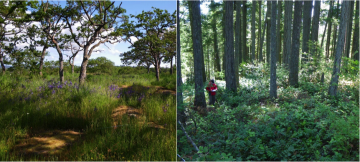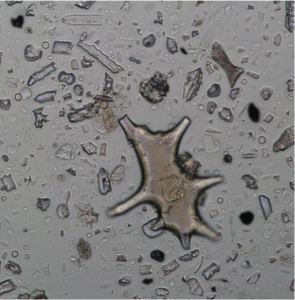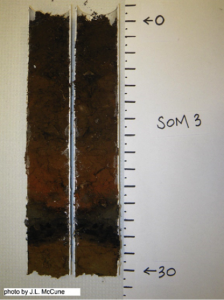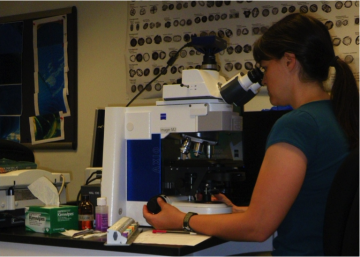I became an ecologist for the love of being out in leafy forests and wide mountain vistas. I was never thrilled by the idea of staring into a microscope for hours on end. But it’s amazing what a scientist will do to fill in just one little piece of the biodiversity puzzle.

A sunny oak savannah contrasts with a shadier Douglas-fir forest. Both are found near Victoria, on Vancouver Island. Photos by Jenny McCune.
Oak savannahs and Douglas-fir forests are beautiful, with hundreds of amazing plants growing in them. But they aren’t like a painting, forming the same picturesque background year after year. They are complicated systems (ecosystems, you might say) that morph and change through time. A shady fir forest today may have been a grassy savannah just a few centuries ago. And that’s what fascinates me: how dynamic these systems are. What did they look like long before photographers or land surveyors ever set foot there? What causes a shift from one type of vegetation to another?

Phytoliths (and some diatoms) as viewed under the microscope. The largest one in the middle is produced by Douglas-fir needles and is about 1/5th of a millimetre long. Photo by Jenny McCune.
I wanted to help fill in this little puzzle piece, and one of my grad school advisors said: well, what about phytoliths? I said: what’s a phytolith? Soon I found myself collecting over 70 different plant species from forests and savannahs, washing them, and incinerating them at very high temperatures. Then I spent hours examining the ash under the microscope in order to catalogue the different shapes of small, silica-based bodies called phytoliths which are formed in plant cells. Different plant species produce phytoliths with different shapes. I collected dozens of soil samples from savannahs and forests across southeastern Vancouver Island. Then I divided them into layers, and followed a bizarre chemical recipe in the lab to remove everything but the phytoliths that had been deposited in the soil over thousands of years, as generations of plants died and decayed. One gram of topsoil can contain over 1 million phytoliths!

A soil core split down the middle, showing the different soil layers. “0” is the soil surface. Photo by Jenny McCune.
Eventually, I spent even more time at the microscope, counting the number of differently shaped phytoliths from different soil samples – I probably counted about 100 thousand individual microscopic phytoliths in all. Then hours entering the numbers, crunching them, analyzing the patterns in soil from different places. What did it all mean? How steady were the savannahs and forests of Vancouver Island before European colonization?
The answer: it depends. It turns out some oak savannahs have been oak savannahs for at least 2,000 years. On the other hand, some places that now are deep dark fir forests are actually former savannahs that started filling in with Douglas-fir in the past. Some started filling in when Europeans arrived in the mid-1800s, and stopped the Coast Salish people from doing their customary burns of the landscape. But others were already starting to change centuries before that. Why? It might have been the climate, or it might have been changes in how the people were managing the vegetation, or maybe a bit of both. It will take more puzzle pieces to figure that out for sure.

Counting phytoliths at the microscope. Photo by Marlow Pellatt.
So after 5 years of graduate school, and another year working on writing and revising the final manuscript, the scientific paper that came out of all this work is about to be published. When I tell my sister (who works in the arts) all about plants and phytoliths and statistics and scientific journals, she says: “you scientists sure live in a strange world”. Maybe she’s right. But if you ask me, was it all worth it just to fit in that one little puzzle piece?
Absolutely.
Jenny McCune is featured in our Researchers Revealed display. See her poster here.
